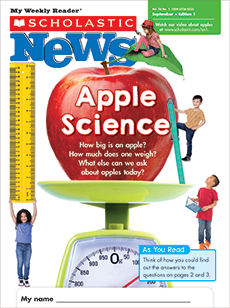Academic Standards
Learning Objective:
Children will discover properties of the moon.
Science Focus:
the moon and space
Page 4 Skill:
observing the sky
Vocabulary:
astronauts, crater, full moon
CCSS:
RI.1.1 ask and answer questions; RI.1.4 determine meaning of words; RI.1.10 read informational texts; RF.1.3 decode words; W.1.8 gather information; W.1.2 writing; SL.1.1 participate in collaborative conversations
Watch the video
Watch the video
Build background knowledge about space by watching “Would You Like to Be an Astronaut?” When you’re done watching, ask the following question: If you were an astronaut, what would be your favorite part of the job?
Preview new vocabulary words
Preview new vocabulary words
Project the online vocabulary slideshow and introduce this issue’s featured words.
Set a purpose for reading
Set a purpose for reading
- Have students do a picture walk through the issue, then read and discuss the cover. Ask students to predict what it would be like to visit the moon.
- Then, before turning to page 2, say, “As we read the article, think about what it is like to be on the moon.”
- As you read, pause after each box. How is living on the moon like life on Earth? How is it different?
- Complete the page 4 activity as a group or individually.
- When you’re done reading, do the Dance Break!
- Reading Checkpoint (skill: reading comprehension)
- A Letter From Norbert Know-It-All (skill: text evidence, writing)
- Return your letters to [email protected].
- Color By Vowel Sound (skill: vowel sounds)
Deepen students’ learning with any of these supplemental activities:
Play the online game: Space Concentration
(skill: vocabulary)
Complete a hands-on activity: Me on the Moon
Kids reflect on what they have read about by imagining what their life on the moon would be like and writing about their “experiences.” (skill: writing)
Read a paired text
Moon! Earth’s Best Friend by Stacy McAnulty follows our moon’s formation, history, and importance—all told from Moon’s perspective.
